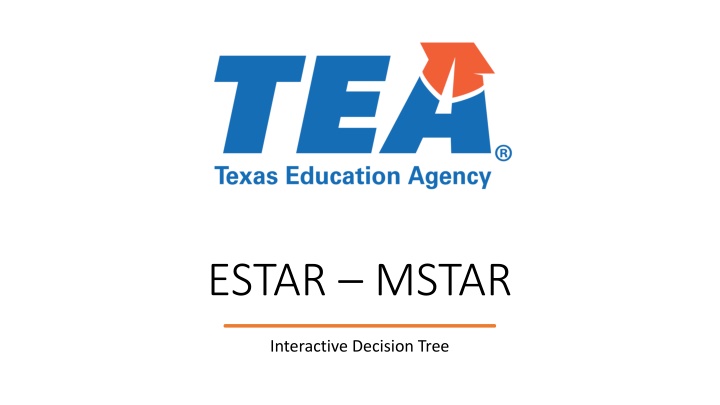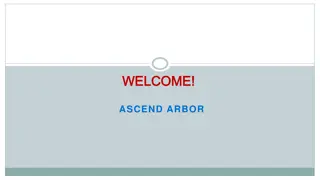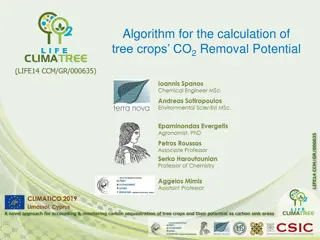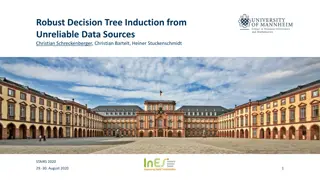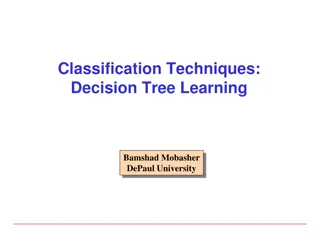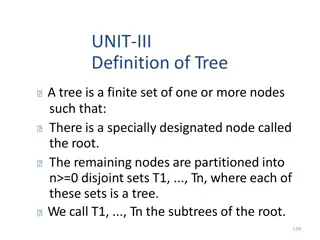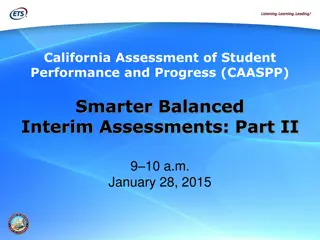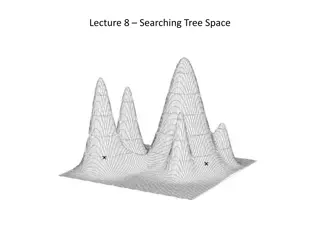Interactive Decision Tree for E/MSTAR Assessments
This resource supplements the E/MSTAR Diagnostic Assessments by guiding educators on when and how to administer these assessments based on student performance tiers. It emphasizes the importance of using the Universal Screener results to determine the appropriate assessment level for struggling students. The decision tree offers clear steps, including additional assessments and instructional strategies, to support student progress effectively.
Download Presentation

Please find below an Image/Link to download the presentation.
The content on the website is provided AS IS for your information and personal use only. It may not be sold, licensed, or shared on other websites without obtaining consent from the author.If you encounter any issues during the download, it is possible that the publisher has removed the file from their server.
You are allowed to download the files provided on this website for personal or commercial use, subject to the condition that they are used lawfully. All files are the property of their respective owners.
The content on the website is provided AS IS for your information and personal use only. It may not be sold, licensed, or shared on other websites without obtaining consent from the author.
E N D
Presentation Transcript
ESTAR MSTAR Interactive Decision Tree
Disclaimer: This resource is intended to supplement the administration of the ESTAR/MSTAR Diagnostic Assessments. It is not intended to replace the ESTAR/MSTAR Diagnostic Assessments or Learning Progressions professional development courses. Use the ESTAR/MSTAR Decision Tree along with student work samples to determine an appropriate ESTAR/MSTAR Diagnostic Assessment to administer. Then, verify your decision by reading the description of the assessment in the ESTAR/MSTAR Assessment Guide. Remember, only students identified on the ESTAR/MSTAR Universal Screener as struggling (Tier 2 or Tier 3) should be administered an ESTAR/MSTAR Diagnostic Assessment.
START Has the student taken the ESTAR/MSTAR Universal Screener? No Yes
You chose No! The student must first take the ESTAR / MSTAR Universal Screener. Begin Again
You chose Yes! In what tier was the student placed per the Universal Screener Report? Tiers 2 or 3 Tier 1B Tier 1A
You chose Tier 1A! The student continues core instruction. Use differentiation strategies and regular progress monitoring Begin Again
You chose Tier 1B! Gather more information from formative and summative assessments. Is a diagnostic assessment necessary? No Yes
You chose No! The student continues core instruction. Use differentiation strategies and regular progress monitoring Begin Again
You chose Yes! Based on the content the student has been taught, the student is struggling with which concepts? Understanding and Applying Whole Number Operations Understanding and Applying Rational Numbers Variables and Expressions Foundation of Rational Numbers
You chose either Tier 2 or 3! Based on the content the student has been taught, the student is struggling with which concepts? Understanding and Applying Whole Number Operations Understanding and Applying Rational Numbers Variables and Expressions Foundation of Rational Numbers
You chose Understanding and Applying Whole Number Operations Does the student demonstrate conceptual understanding and procedural fluency with addition and subtraction of whole numbers? No Yes
You chose Foundations of Rational Numbers Is the student able to use visual representations and reason about fractions less than or equal to one whole? No Yes
You chose Understanding and Applying Rational Numbers Is the student able to represent positive rational numbers (e.g. equivalent fractions, decimals, and conversions between representations)? No Yes
You chose Variables and Expressions Is the student able to evaluate and simplify expressions? No Yes
You chose No! Does the student demonstrate conceptual understanding of addition and subtraction within 20 and place value within 120? No Yes
You chose No! Does the student understand magnitude, equipartitioning, and decomposition of a fraction? No Yes
You chose Yes! Has the student demonstrated an understanding of multiplication for up to 10 x 10 and division up to 100 10 (without remainders)? No Yes
The Student should take AS.A Foundations of Addition and Subtraction of Whole Numbers For whole numbers less than or equal to 120: Represent, compose, decompose, and compare whole numbers using pictures/objects, place value models, number lines, and numerals For whole numbers less than or equal to 20: Represent unknown values, joining, separating, or comparison contextual situations, with pictures or numerals Identify expressions/equations that represent joining, separating, or comparison contextual situations where the unknown value is in any position Identify inverse relationship between addition and subtraction using models and equations Begin Again
The student should take AS.B Applications of Addition and Subtraction of Whole Numbers For two- and three-digit numbers: Add and subtract multiples of ten and a 2-digit number or multiples of one-hundred and a 3-digit number using place value models and properties of numbers and operations Add and subtract whole numbers Identify expressions/equations that represent joining, separating, or comparison contextual situations where the unknown value is in any position Find the unknown value in joining, separating, or comparison contextual situations. Begin Again
The student should take MD.A Foundation of Multiplication and Division of Whole Numbers For multiplication up to 10 x 10 and division up to 100 10: Represent equal groups with objects, number lines, or arrays/area models Represent contextual situations involving measurement and partitive division without remainders using objects, number lines, or arrays/area models Recognize multiplication patterns Identify inverse relationship between multiplication and division using models and equations Use arrays and area models to show conceptual understanding of the commutative and associative property of multiplication and the distributive property of multiplication over addition Find the unknown value in contextual situations for multiplication of equal groups, measurement division, and partitive division Identify expressions/equations that represent multiplication of equal groups, measurement division, and partitive division contextual situations Begin Again
The Student should take MD.B Applications of Multiplication and Division of Whole Numbers For division up to 100 10: Represent contextual situations involving measurement and partitive division with remainders using objects, number lines, or arrays/area models For multiplication up to 4-digit by 1-digit or 2-digit by 2-digit and division up 4-digit divided by 1 digit: Use place value understanding to multiply multiples of 10, 100, or 1000 Represent the product of numbers using place value models, area models, and/or properties of operations with expressions Identify inverse relationships between multiplication and division using models and equations Interpret the meaning and implication of remainder in contextual situations Multiply and divide whole numbers Find the unknown value in contextual situations for multiplication of equal groups, measurement division, and partitive division Begin Again
The student should take FR Fractions as Numbers For fractions less than or equal to 1 or where denominators represented are 2, 3, 4, 6, or 8: Partition sets of objects, areas, and number lines Understand the verbal language and symbolic notation for unit fractions represented by areas, sets, and number lines Reason with fractional parts to show an understanding that partitioning the same whole into a greater number of parts will produce smaller partitions Connect unit fractions to non-unit fractions conceptually, verbally, and symbolically Represent equivalent fractions using area models and number lines, and justify/explain why the fractions are equivalent based on the model Begin Again
The student should take RN.A Understanding Fractions Understand the magnitude of whole numbers and fractions Partition whole and different-sized shapes, and combined partitioned parts Compose and decompose fractions using addition and multiplication Begin Again
The student should take RN.B Representations of Positive Rational Numbers Represent and generate equivalent fractions Write, compare, and represent decimals Compare fractions by using visual models, reasoning about the numerators and denominators, and finding a common denominator Identify and generate equivalent fractions and decimals Begin Again
The student should take RN.C Applications of Positive Rational Numbers Understand attributes of ratios, and identify equivalent ratios Identify, apply, and extend unit rates Model and solve addition and subtraction problems with rational numbers Model and solve multiplication problems with rational numbers Model and solve division problems with rational numbers Begin Again
The student should take VE.A Understanding Variable and Expressions Identify, describe, and use variables as unknown quantities Evaluate single and multi-variable expressions Translate between verbal descriptions and symbolic representations of equations and expressions Simplify expressions with whole numbers, rational, or unwritten coefficients Begin Again
The student should take VE.B Expressions and Equations Understand the relationship between expressions Solve single variable equations using a variety of methods Begin Again
